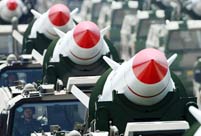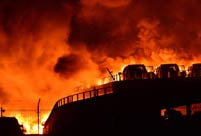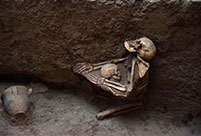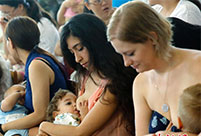

Luo Linquan (standing at right), Chinese consul general in San Francisco, addresses the opening ceremony of the WWII Pacific War Memorial Hall on Aug 15 in San Francisco Chinatown. Florence Fang (fifth from left), curator of the memorial hall, and He Yafei (fourth from left), deputy director of the Overseas Chinese Aff airs Office of the State Council, were among the guests attending the ceremony. CHANG JUN / CHINA DAILY
On a bustling sloped street in San Francisco's Chinatown, a building, which has housed overseas Chinese people's memories of more than 80 years, is embarking on a new mission as a museum - to tell the story of the Chinese people's suffering under Japanese aggression during WWII.
The white, three-story building used to house the Chinese Daily Post in 1927, one of the first Chinese newspapers in the United States. During WWII, the building served as a center for overseas Chinese to gather and rally support for their homeland.
Through a 400-day-long effort by organizers, the building has now become the WWII Pacific War Memorial Hall, the first and only one of its kind outside China, as of Aug 15, 2015, the 70th anniversary of the end of WWII and the Chinese People's War of Resistance against Japanese Aggression.
"On Aug 15, 1945, Japan announced its unconditional surrender. Seventy years later, we choose this same date, as the day to have the grand opening of this first Overseas China WWII Pacific War Memorial Hall," said Florence Fang, curator of the memorial hall and a well-known entrepreneur and philanthropist in the San Francisco Bay Area, during the opening ceremony.
"This memorial hall's spirit and goal is to respect history and to cherish peace," she said, "to commemorate all WWII soldiers and civilians, who sacrificed and even gave their lives, fighting for liberty and peace. Without respecting history, there's no justice in the world; without learning from war's lessons, there's no peace in the world."
In the 5,000-square-foot museum are more than 100 artifacts of historic interest and hundreds of historical photos covering the most important aspects of the war, from the pre-Japanese-invasion period from 1931 to 1937 to the Chinese people's resistance on their own terms from 1937 to 1941, the US involvement from 1942 to 1945 and the wartime alliance between the US and China and overseas Chinese people's support.
Among the artifacts are Fang's own collection, loans from China's State Administration of Cultural Heritage and individuals as well as donations from the Flying Tigers Historical Organization and overseas Chinese, said Jia Li, one of the exhibition's planners.
"The audience has a chance to view the exhibits of historic significance, such as the sword of the Class A war criminal and mastermind of the Nanking Massacre, Iwane Matsui, and they also have a chance to experience the touching moments during the cruel war years, like the original copies of a Chinese expeditionary army soldier's note of death in battle and letters from his father," said Li.
"War is cruel, which makes me feel that we are so lucky living in peace time," said Vincent Han, a 12-year-old volunteer guide who is responsible for introducing the exhibition's third chapter on China's Counteroffensives.
Han said he spent two weeks preparing for the introduction and that it was "worth it". "I now have a better understanding of this history myself and I'm glad to be able to help other people better understand it, too," he said.
 |
 Indomitable Chinese people during WWII
Indomitable Chinese people during WWII
 Awesome Chinese missiles
Awesome Chinese missiles In pics: shocking aftermath of Tianjin blasts
In pics: shocking aftermath of Tianjin blasts
 Striking moments when strategic missiles are launched
Striking moments when strategic missiles are launched Construction on Asia’s biggest suspension bridge started
Construction on Asia’s biggest suspension bridge started Impressive firing of China’s rocket artillery system
Impressive firing of China’s rocket artillery system Shocking scenes found in 4000-year-old earthquake relic
Shocking scenes found in 4000-year-old earthquake relic Female soldiers add color to military parades
Female soldiers add color to military parades Mums stage breastfeeding flash mob
Mums stage breastfeeding flash mob Museum of nonsense
Museum of nonsense Tianjin explosion: Latest updates
Tianjin explosion: Latest updates Tianjin officials fumble to communicate
Tianjin officials fumble to communicate Blaze and glory: brilliant photos of China's mountain firefighters on the frontlines
Blaze and glory: brilliant photos of China's mountain firefighters on the frontlinesDay|Week